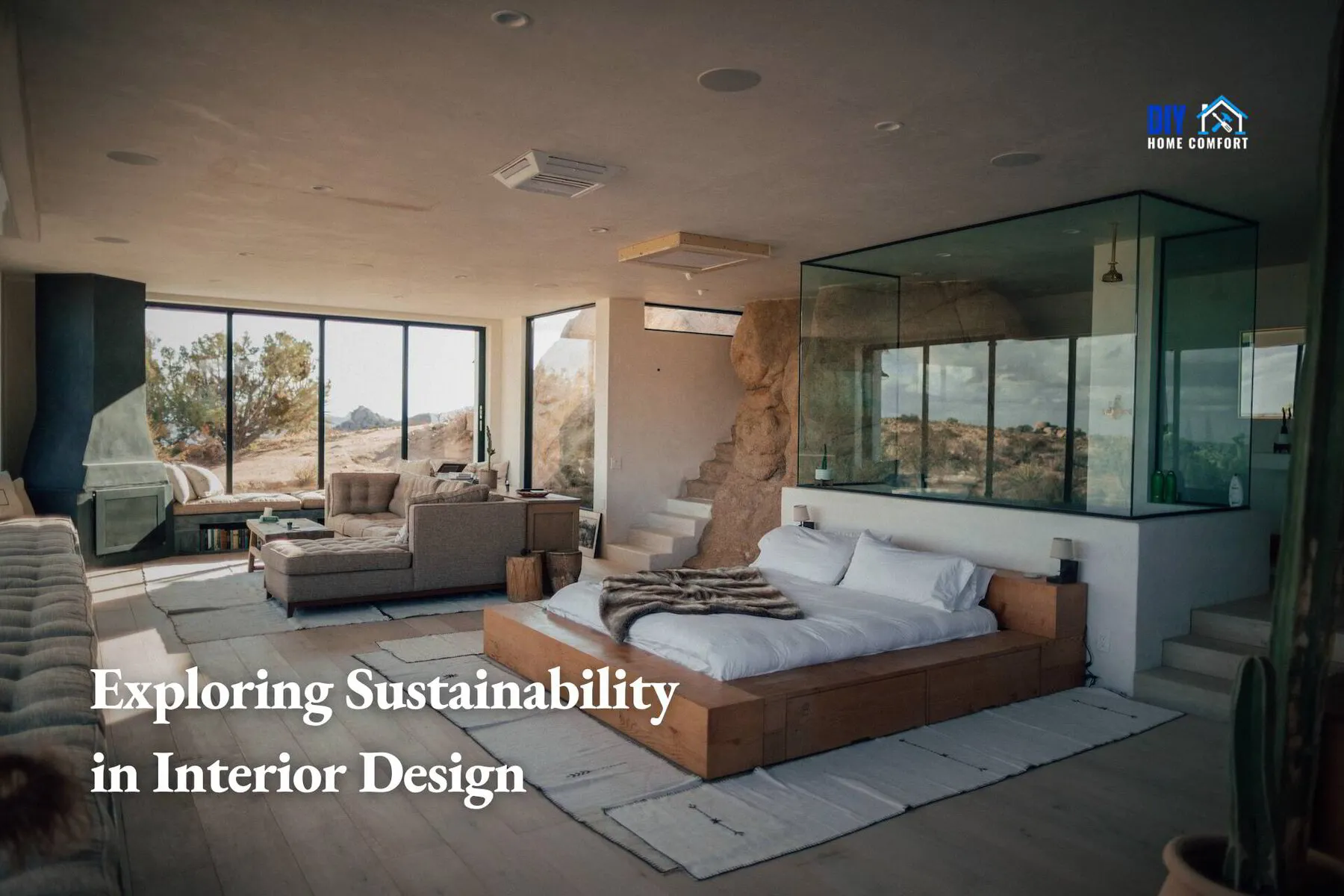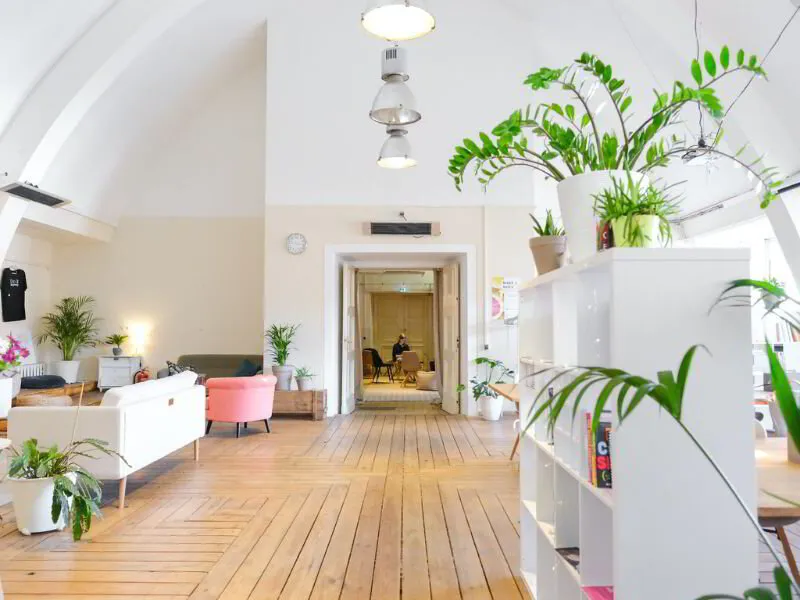As the world grapples with climate change's consequences, the need for sustainable living has become more apparent than ever before.
Every aspect of our lives should incorporate sustainability principles, from our daily routine to the spaces we occupy.
In that regard, interior design is crucial in improving energy efficiency and creating spaces that promote sustainable living.
This article will delve into the importance of sustainability in interior design, the array of sustainable materials and products, energy efficiency solutions, and biophilic design principles.
📘 Key Takeaways
- Eco-Friendly Choices: Sustainable interior design greatly emphasizes the use of eco-friendly materials and products, such as reclaimed materials and low-VOC paints, to reduce carbon footprint and create unique spaces.
- Energy Efficiency: Incorporating energy-efficient appliances and lighting in your design strategy can lead to significant cost savings through reduced energy consumption.
- Health and Well-being: Sustainable design promotes healthier indoor air quality, contributing to improved public health and well-being.
- Social Responsibility: Opting for sustainable interior design is a step towards social responsibility and environmental conservation.
- Long-term Savings: This approach leads to long-term savings by using durable, low-maintenance materials that withstand the test of time.
🍃 The Importance of Sustainability in Interior Design
Sustainability in interior design goes beyond creating aesthetically pleasing spaces.
It entails incorporating design elements that meet environment, economic, and social needs.
Additionally, sustainable design seeks to reduce resource consumption, minimize waste production and toxic emissions and create safe, healthy, and comfortable spaces for occupants.
💚 Environmental Benefits
Sustainable interior design significantly reduces environmental impact through several vital practices:
Eco-Friendly Materials and Products:
The selection of eco-friendly materials is a cornerstone of sustainable design.
By choosing options like bamboo, cork, and reclaimed wood, not only do we minimize the carbon footprint and reduce pollution, but we also support the cycle of sustainability.
These materials are renewable and have a lower environmental impact than traditional construction materials.
Energy-Efficient Design:
A focus on energy efficiency is crucial in reducing the use of non-renewable natural resources.
Implementing energy-efficient design elements, such as LED lighting and energy-saving appliances, plays a significant role in decreasing greenhouse gas emissions.
LED lights, for example, consume less energy and have a longer lifespan than traditional bulbs, making them a sustainable choice for both the environment and the consumer.
Natural Materials in Green Spaces:
Incorporating natural materials is not just about aesthetics; it's about embracing materials that are inherently eco-friendly.
Bamboo, cork, and reclaimed wood are not only sustainable but also add a unique, organic feel to interior spaces.
These materials often require less processing and fewer resources to produce, further reducing their environmental impact.
Reducing Environmental Impact:
The use of energy-efficient lighting and appliances is a practical step towards sustainability.
By choosing products that consume less energy and have a longer operational life, we can significantly reduce the environmental impact of our interior spaces.
This approach aligns with the broader goal of sustainable living, which aims to reduce our ecological footprint and promote a healthier planet.
Sustainable interior design offers a path to reduce environmental impact through the thoughtful selection of materials and energy-efficient practices.
These choices contribute to a healthier environment and align with a growing global commitment to sustainability.
💚 Economic Benefits of Sustainable Interior Design
Sustainable interior design is an environmentally conscious choice and a financially smart one, offering substantial cost savings across various aspects.
Reduced Energy Consumption for Lower Bills
One of the most immediate benefits is the reduction in energy consumption, thanks to energy-efficient features.
This leads to noticeably lower utility bills, a benefit that is equally valuable in residential and commercial settings. Energy efficiency is not just about using less; it's about spending less.
Attracting Eco-Conscious Consumers
For businesses, adopting green design practices serves as a unique selling point. It attracts a growing demographic of eco-conscious consumers, providing a competitive edge in the market.
This aspect of sustainable design can translate into increased customer loyalty and brand value.
Durability and Low Maintenance: Long-Term Savings
Sustainable design also involves choosing durable, low-maintenance materials. For example, high-quality recycled glass used in countertops and tiles not only adds to the aesthetic value but also reduces the need for frequent replacements.
This longevity translates into significant long-term savings in terms of money and resources.
A Holistic Economic Approach
In essence, sustainable interior design represents a holistic approach to economic efficiency.
It reduces immediate costs like energy bills, reduces long-term expenses through durable materials, and opens up new market opportunities. It's a strategy that aligns financial prudence with environmental responsibility.
The economic advantages of sustainable interior design are clear and multifaceted.
It's an approach that proves being environmentally responsible can also be economically beneficial, making it an attractive choice for both individuals and businesses.
💚 Social Impact of Sustainable Interior Design
Promoting Healthier Living Environments
Sustainable design extends its benefits beyond environmental conservation, significantly impacting social aspects. One of the key social benefits is the promotion of healthier indoor environments.
Sustainable interior design plays a vital role in enhancing indoor air quality by prioritizing the use of non-toxic and non-allergenic materials in building and design.
This shift towards healthier materials ensures that our spaces are safe and conducive to well-being, reducing the risk of health issues associated with toxic building materials.
Enhancing Public Health in Community Spaces
The impact of sustainable design is particularly profound in communal spaces like schools and hospitals.
In these environments, integrating sustainable practices can lead to improved public health and well-being.
For instance, using natural light and ventilation reduces energy consumption and creates a more comfortable and healing atmosphere, which is essential in healthcare settings.
Similarly, in educational facilities, sustainable design can contribute to creating a more conducive learning environment, positively affecting students' focus and well-being.
Fostering Social Responsibility
Sustainable interior design also plays a pivotal role in promoting social responsibility.
Individuals and businesses demonstrate a commitment to the broader goal of environmental conservation by choosing environmentally responsible design practices.
This approach encourages a culture of sustainability, where the choices made in design and construction reflect a collective responsibility toward preserving our planet for future generations.
Sustainable interior design profoundly impacts social well-being by promoting healthier indoor environments through non-toxic materials, especially in critical spaces like homes, schools, and hospitals.
It also fosters social responsibility, encouraging a community-wide commitment to environmental conservation.
This approach benefits current populations and demonstrates a dedication to protecting the planet for future generations, making sustainable design a key factor in building healthier, more responsible communities.
🍃 Embracing Sustainable Materials and Products in Interior Design
The realm of sustainable interior design offers a plethora of choices for those committed to environmental stewardship.
From innovative eco-friendly textiles to creatively repurposed materials, the options for sustainable design are both diverse and accessible.
The Rise of Eco-Conscious Choices
Interior designers and homeowners increasingly gravitate towards low Volatile Organic Compounds (VOC) paints and finishes.
This shift is driven by a growing awareness of these products' health and environmental benefits. However, the significance of choosing sustainable materials and products extends far beyond current trends.
Why Sustainable Materials Matter
Sustainable materials and products are defined not just by their end use but by their entire lifecycle — from production to disposal.
These materials are crafted using methods that minimize environmental impact, thereby contributing to the preservation of our planet.
By opting for sustainable choices, we directly reduce our carbon footprint and ensure a healthier environment for future generations.
The Added Value of Sustainability
Beyond their environmental benefits, sustainable materials often surpass their conventional counterparts in quality and durability.
These materials are designed to last longer, reducing the need for frequent replacements and thus further diminishing our ecological impact.
This longevity and their minimal environmental footprint make sustainable materials a smart and responsible choice for any interior design project.
In conclusion, adopting sustainable materials and products in interior design is more than a trend; it's a crucial step towards a more responsible and environmentally conscious approach to living.
By making these choices, we contribute to the health of our planet and invest in quality and longevity for our living spaces.
💚 The Advantages of Eco-Friendly Textiles in Interior Design
Eco-friendly textiles are transforming interior spaces with their sustainable and health-conscious attributes. Key materials in this category include organic cotton, linen, and bamboo, each offering unique benefits.
Organic Cotton: A Sustainable Choice
Organic cotton is a standout in the realm of eco-friendly textiles. Grown without synthetic fertilizers and pesticides, it significantly reduces the release of harmful chemicals into the environment.
This mindful cultivation process benefits the planet and enhances the quality of the cotton itself, resulting in a purer, more durable fabric.
Linen: Combining Durability and Comfort
Linen, derived from the fibers of the flax plant, is celebrated for its durability and breathability. This natural fiber is an excellent choice for interior design elements, offering a blend of comfort and resilience.
Its minimal processing requirements make it a sustainable choice, further reducing the environmental impact.
Bamboo: Softness Meets Sustainability
Bamboo textiles are gaining popularity due to their incredible softness and eco-friendly properties. As one of the fastest-growing plants, bamboo requires minimal water and pesticides, making it a highly sustainable resource.
Its rapid growth and low maintenance needs make bamboo textiles an exemplary choice for those seeking both comfort and sustainability.
Impact on Spaces and the Environment
Incorporating these eco-friendly textiles into bedrooms, living rooms, and other interior spaces promotes sustainability and creates a cozy and relaxing atmosphere.
By choosing biodegradable materials grown without harmful chemicals, we significantly reduce waste production and contribute to a healthier living environment.
In conclusion, eco-friendly textiles like organic cotton, linen, and bamboo offer a harmonious blend of environmental responsibility, quality, and aesthetic appeal.
Their use in interior design is a testament to a growing commitment to sustainability and well-being in our living spaces.
💚 Integrating Recycled and Reclaimed Materials in Interior Design
The use of recycled and reclaimed materials like wood, metal, and glass is revolutionizing interior design, offering both aesthetic appeal and environmental benefits.
Reducing Waste Through Repurposing
Repurposing old materials is a key strategy in sustainable design. We significantly reduce waste and support sustainability efforts by giving new life to previously used materials.
This practice conserves resources and minimizes the carbon footprint associated with producing new materials.
Reclaimed Wood: Crafting Unique Pieces
Reclaimed wood is a prime example of this sustainable approach. It can be transformed into stunning furniture pieces, each with its own history and character.
This adds a unique aesthetic to interior spaces and tells a story of sustainability and conscious living.
Old Metal: From Scrap to Chic
Similarly, old metal finds a new purpose in interior design. It can be creatively repurposed into lighting fixtures, decorative accents, or even functional art pieces.
This reduces the need for new metal production and adds an industrial charm to the decor.
Recycled Glass: Transforming Interiors
Recycled glass is another versatile material capable of being transformed into beautiful tiles, countertops, or decorative elements.
This process not only gives a new lease of life to used glass but also contributes to reducing the environmental impact of glass production.
The Endless Possibilities of Sustainability
The possibilities with recycled and reclaimed materials are indeed endless. Each piece brings a unique story and an element of sustainability into interior spaces.
By choosing these materials, designers and homeowners can create visually appealing spaces while positively impacting the environment.
Incorporating recycled and reclaimed materials in interior design is more than a trend; it's a commitment to environmental responsibility and creative innovation.
These materials offer a way to reduce environmental impact while adding unique and personalized touches to any space.
💚 Embracing Low VOC Paints and Finishes for Healthier Interiors
The shift towards low-VOC paints and finishes marks a significant step in sustainable interior design, prioritizing human health and environmental well-being.
Healthier Choices for Indoor Environments
Low-VOC paints and finishes are formulated with reduced harmful chemicals, making them a safer choice for indoor environments.
Their use in interior design not only supports sustainability initiatives but also significantly improves indoor air quality.
This is particularly important in residential and commercial spaces where air quality directly impacts the health and comfort of occupants.
The Downside of Traditional Paints
Traditional paints and finishes are often laden with high levels of VOCs, which can harm human health.
These compounds contribute to indoor air pollution and can lead to various health issues, from respiratory problems to more severe long-term effects.
Therefore, the transition to low-VOC alternatives is not just an environmental choice but a health-conscious one.
Benefits of Low-VOC Options
Low-VOC products release fewer harmful emissions into the air, ensuring inhabitants a safer and healthier environment.
This makes them ideal for spaces where health and safety are paramount, such as homes, schools, and healthcare facilities.
Sustainability and Aesthetic Appeal
Incorporating sustainable materials like low-VOC paints and finishes into interior design goes beyond environmental benefits; it also contributes to creating aesthetically pleasing and unique spaces.
These products are available in various colors and finishes, allowing for creative and personalized design choices.
A Commitment to a Sustainable Future
By opting for sustainable materials and products, we play a crucial role in shaping a sustainable future.
Choosing low-VOC paints and finishes is a testament to our commitment to preserving the planet for future generations while ensuring our immediate surroundings are healthy and safe.
In conclusion, using low-VOC paints and finishes in interior design is crucial to sustainable living. It represents a thoughtful choice for healthier living spaces, contributing to the overall well-being of individuals and the planet.
🍃 Energy Efficiency in Interior Design
Energy efficiency is a significant aspect of sustainable interior design. Incorporating energy-efficient solutions not only promotes sustainability but also leads to reduced energy bills for occupants.
There are numerous ways to incorporate energy efficiency into interior design, ranging from natural lighting solutions to smart home technologies.
💚 Natural Lighting Solutions
Integrating natural lighting solutions like skylights, large windows, light tubes, and light shelves is a key aspect of energy-efficient interior design.
These elements significantly reduce the reliance on artificial lighting, leading to energy conservation and cost savings.
Skylights and Large Windows: Brightening Spaces
Skylights and expansive windows are pivotal in maximizing natural light in interior spaces.
They diminish the need for electrical lighting and enhance the ambiance, creating bright and inviting environments in living rooms, dining areas, and other spaces.
Innovative Solutions: Light Tubes and Shelves
Light tubes offer an innovative and cost-effective method to channel natural light into areas that may not have direct access to windows.
This solution is particularly effective in bringing daylight to central parts of a building, reducing the need for artificial lighting during daytime hours.
Light shelves, on the other hand, are designed to reflect natural light deeper into a room. Positioned strategically, these shelves can distribute light more evenly, illuminating spaces more effectively and reducing the need for additional light sources.
The Impact of Natural Lighting
The incorporation of these natural lighting solutions not only contributes to energy efficiency but also improves the overall well-being of occupants.
Natural light boosts mood and productivity, making it a valuable element in any interior design.
Natural lighting solutions are an essential component of sustainable interior design. They offer a practical approach to reducing energy consumption while creating aesthetically pleasing and healthful environments.
💚 Integrating Energy-Efficient Appliances and Electronics for Sustainable Living
Embracing energy-efficient appliances and electronics is a cornerstone of sustainable interior design. This approach not only reduces energy consumption but also minimizes the environmental impact of our daily lives.
Eco-Friendly Electronics: A Step Towards Sustainability
Opting for eco-friendly electronics, such as solar-powered devices or those with rechargeable batteries, is a proactive step towards environmental conservation.
These choices significantly reduce reliance on non-renewable energy sources and decrease the overall carbon footprint of a household.
A Wide Range of Energy-Efficient Options
Today's market offers a diverse array of energy-efficient appliances and electronics, catering to every aspect of domestic life.
These products, from refrigerators and washing machines to televisions and computers, are designed to deliver optimal performance while consuming minimal energy.
The Importance of ENERGY STAR Certification
When selecting appliances and electronics, one key indicator of energy efficiency is the ENERGY STAR label.
This certification, established by the U.S. Environmental Protection Agency (EPA), signifies compliance with stringent energy efficiency guidelines.
Products bearing this label are not only better for the environment but can also lead to significant savings on energy bills over time.
The Impact of Energy-Efficient Choices
Incorporating energy-efficient appliances and electronics into interior design is more than a trend; it's a commitment to a more sustainable and responsible lifestyle.
By choosing products that align with these principles, individuals can contribute to a larger movement toward environmental stewardship while enjoying the benefits of modern technology.
Integrating energy-efficient appliances and electronics in interior design plays a vital role in promoting sustainability.
It represents a thoughtful balance between enjoying technological advancements and being mindful of our environmental responsibilities.
💚 Leveraging Smart Home Technologies for Energy-Efficient Interior Design
Integrating smart home technologies is revolutionizing interior design with a focus on energy efficiency and sustainability.
These innovative solutions, including smart thermostats, lighting systems, plugs, and blinds, are instrumental in reducing energy consumption and enhancing the functionality of living spaces.
Smart Thermostats: Optimizing Temperature Control
Smart thermostats stand at the forefront of this technological shift. By intelligently regulating indoor temperatures, they ensure optimal comfort while minimizing energy usage.
This leads to lower energy bills and contributes significantly to environmental sustainability.
Intelligent Lighting Systems: A Bright Idea
Smart lighting systems are another key component of energy-efficient design. These systems allow for precise control over lighting levels, enabling homeowners to reduce energy consumption while maintaining the desired ambiance in their homes.
Beyond the Basics: Smart Plugs and Blinds
The scope of smart home technology extends to devices like smart plugs and blinds. Smart plugs offer control over the energy usage of appliances and electronics, turning any device into an energy-efficient solution.
Smart blinds, meanwhile, can be programmed to adjust based on the time of day and sunlight levels, optimizing natural light usage and reducing the need for artificial lighting.
The Impact of Energy-Efficient Choices
Adopting these smart technologies in interior design enhances energy efficiency and provides a level of convenience and control previously unattainable.
By automating various aspects of home management, these technologies allow for a more sustainable, comfortable, and efficient living environment.
Smart home technologies are an essential element of modern, energy-efficient interior design. They represent a harmonious blend of innovation, sustainability, and practicality, paving the way for smarter, more responsible living spaces.
💚 Embracing Green Materials for Sustainable and Energy-Efficient Interior Design
Incorporating green materials into interior design is pivotal to achieving sustainability and enhancing energy efficiency.
These materials, characterized by their environmental friendliness and low energy consumption in production and transportation, transform how we approach interior spaces.
Eco-Friendly Choices: Bamboo, Cork, and Recycled Glass
Key examples of green materials include bamboo, cork, and recycled glass. Bamboo, known for its rapid growth and minimal resource requirements, is a highly sustainable option.
Cork, harvested from the bark of cork oak trees without harming the tree, offers a renewable and biodegradable solution.
Recycled glass, repurposed from used glass products, reduces the need for raw materials and energy-intensive manufacturing processes.
Energy Efficiency in Production and Transportation
These green materials are not only environmentally friendly but also more energy-efficient compared to traditional materials.
The reduced energy required for their production and transportation contributes significantly to lowering the overall carbon footprint of a building project.
Durability: A Key Factor in Sustainable Design
When selecting materials for interior design, it's crucial to consider their durability. Durable materials withstand the test of time, requiring less frequent replacement and thus reducing waste and resource consumption.
This longevity is an essential component of sustainable design, ensuring that interior spaces remain both beautiful and environmentally responsible for years to come.
The Broader Impact of Green Materials
Using green materials in interior design goes beyond aesthetic appeal; it reflects a commitment to environmental stewardship and a sustainable future.
By choosing these materials, designers, and homeowners make a conscious decision to support eco-friendly practices and reduce the environmental impact of their spaces.
In conclusion, green materials are an integral part of energy-efficient and sustainable interior design.
They offer a harmonious blend of functionality, beauty, and environmental responsibility, paving the way for a greener and more sustainable approach to designing our living spaces.
💚 Incorporating Natural Elements
From incorporating plants and natural materials to using color schemes that mimic natural landscapes, biophilic design seeks to bring nature indoors, creating spaces that promote a sense of peace and tranquility.
Incorporating natural elements into interior design can reduce stress levels and improve mental health.
💚 Indoor Air Quality and Ventilation
Biophilic design emphasizes indoor air quality and ventilation.
Ensuring indoor air quality is healthy reduces the risk of allergies and respiratory illnesses, promoting sustainable living.
💚 The Psychological Benefits of Biophilic Design
The psychological benefits of biophilic design cannot be overstated.
Incorporating natural elements into interior design promotes a sense of calm and reduces stress levels, ultimately leading to improved mental health.
🍃 Conclusion
Sustainable interior design is more critical now than ever before.
Incorporating sustainability principles in interior design not only promotes sustainable living but also leads to reduced resource consumption and lower bills for occupants.
From eco-friendly textiles and construction materials to energy-efficient solutions and biophilic design principles, there are countless ways to create a sustainable interior design that promotes healthy living for humans and the environment.
Check out our other interior design articles in the series for more design inspiration and to learn more about interior design.
📘 Related Reading: The 7 Elements of Interior Design
Lara Harding
Lara is a supporting author @ DIY Home Comfort. She's an experienced interior designer and decorator and a full-time mom. You can find out more about her here.






